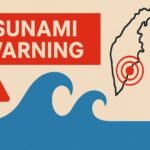Late on Saturday, July 19, a strong 7.5 magnitude earthquake struck off the eastern coast of Russia’s Kamchatka Peninsula. Just minutes later, the Pacific Tsunami Warning Center issued a tsunami watch for the Hawaiian Islands. Phones buzzed with emergency alerts, sirens stood ready, and for a tense hour, Hawaiʻi braced for what could have been a Pacific-wide tsunami.
In the end, there was no damaging wave, no siren blare, no need for evacuations. The tsunami watch was officially canceled less than 40 minutes after it began. But behind that brief alert was a complex chain of decisions, instruments, and international data networks that worked exactly the way they’re supposed to. This wasn’t just a lucky break, it was a successful dress rehearsal for a system built to save lives.
A powerful quake in the Pacific Ring of Fire
At 8:49 p.m. HST, a magnitude 7.5 earthquake shook the seabed near 52.5 degrees north, 160.5 degrees east. That’s off Russia’s far east coast, near the Kuril–Kamchatka Trench, one of the most seismically active zones on Earth. Here, the Pacific Plate slides beneath the Okhotsk Plate, creating violent megathrust quakes every few decades.
The quake wasn’t just big. It was shallow, around 24 kilometers deep, which increases the chances of shifting the seafloor. Vertical displacement of ocean water is what generates tsunamis. And although this region has seen deadly tsunamis in the past, including the 1952 event that sent waves all the way to Hilo, this time was different.
There were foreshocks. One quake at 7.0, another at 6.7. Then came the main 7.5 event. Each of these added uncertainty to early warning models. The Pacific Tsunami Warning Center responded quickly, issuing the tsunami watch for Hawaiʻi at 9:03 p.m.
What a tsunami watch really means
A tsunami watch is not a warning. It means a powerful quake has occurred that might generate a tsunami, and that officials are still evaluating the risk. Watches are usually issued for regions that could be affected within a few hours if waves are generated. In this case, the earliest estimated arrival time for Hawaiʻi was around 2:43 a.m.
Within minutes of the watch being declared, phones across the state buzzed. Wireless emergency alerts told residents to stay tuned. Emergency management teams reviewed evacuation plans.
But behind the scenes, scientists were already watching the deep ocean.
Using a network of DART buoys—pressure sensors placed thousands of feet below the sea—they began checking for signs of tsunami energy moving through the water. If the quake had shifted enough water, those buoys would detect the tiniest pulse.
Instead, they saw almost nothing. Just one to two centimeters of sea-level rise, well below the threshold for concern.
At 9:42 p.m., less than 40 minutes after the tsunami watch was first issued, the Pacific Tsunami Warning Center canceled it.
What we learned from this non-event
Some might call it a false alarm, but that’s not the right term. The tsunami watch was issued based on solid, fast-moving data. The quake met the standard trigger for alert. The watch wasn’t overreaction. It was early action.
The fact that no tsunami occurred isn’t proof that the system is too cautious, it’s proof that the system works. We had time to prepare. We had models that projected impact. And we had live instruments in the water that told us, in real time, this wave wasn’t coming.
These are the layers that make the Pacific tsunami warning system one of the most effective in the world.
The earthquake’s energy was real. But because it released mostly lateral movement along the fault, rather than strong vertical motion, it didn’t displace enough water to send waves across the ocean. This is one of the key factors in whether or not a tsunami happens.
A tsunami watch means pause, not panic. It means there’s a possibility, not a certainty. Emergency managers don’t take chances. They don’t wait to see what happens. They act on potential because lives depend on speed.
Why every tsunami watch deserves attention
Even though this one didn’t result in disaster, it was a reminder of how quickly things can change. The same region that produced this quake has a long record of deadly tsunamis. In 1952, the Kamchatka quake sent waves more than three meters high into Hilo Bay, killing lives and flooding neighborhoods. In that event, there was no warning at all.
Now, with modern modeling and deep-sea sensors, we can see across the ocean in near-real time. Hawaiʻi had a full five-hour cushion had a tsunami been on the way.
If this quake had produced a larger vertical seafloor shift, it could have launched waves that swept across the Pacific, hitting places like Hawaiʻi, the Aleutian Islands, and even parts of California.
That’s why tsunami watches are issued automatically for any quake above magnitude 7.5 in tsunami-prone regions. They’re not a guarantee of danger, but they’re a loud heads-up to get ready, just in case.
The calm before the next storm
So what should we take from this? A few key reminders.
- Always pay attention to tsunami watches, even if they seem like non-events. These alerts are your early warning system. They buy time for communities to act.
- Know your evacuation zones. Every island has maps that show the danger zones. If you live or vacation near the coast, learn your safe routes inland.
- Stay alert at night. Many quakes happen in the early morning hours. Keep your phone’s emergency alerts turned on.
- Watch for natural warnings. If you feel strong shaking near the coast, see the ocean pull back, or hear strange roaring from the sea, evacuate immediately.
This time, Hawaiʻi was lucky. But luck wasn’t the only reason. It was also the result of decades of scientific planning, global cooperation, and public awareness.
The next tsunami watch might not end so quietly. But if you stay prepared, you’ll be ready for whatever comes from across the water.

